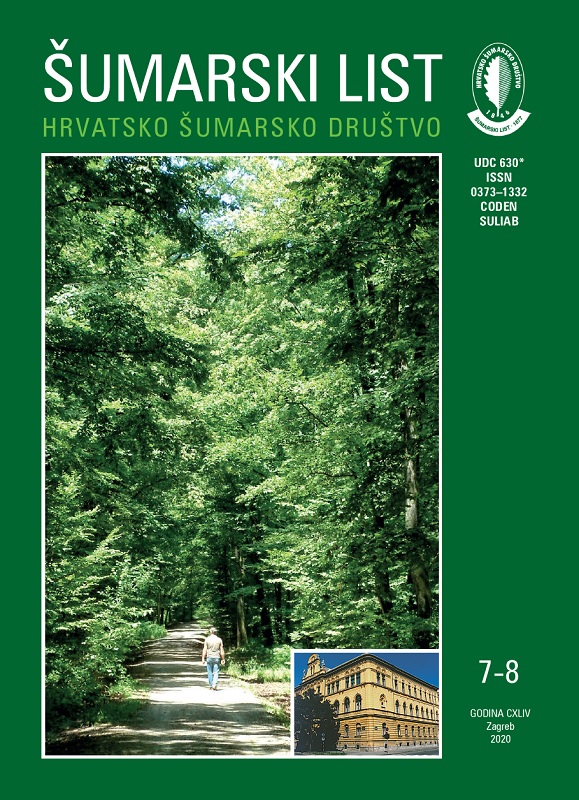
broj: 7-8/2020
pdf (6,01 MB) |
|
||||||||||||||
| RIJEČ UREDNIŠTVA | ||
| Uredništvo | ||
| Parafiscal levies – definition and who should pay them pdf HR EN | 337 | |
| IZVORNI ZNANSTVENI ČLANCI | ||
| Milan Pernek, Marta Kovač, Nikola Lacković | UDK 630* 453 (001) https://doi.org/10.31298/sl.144.7-8.1 | |
| Testing of biological effectiveness of pheromones and traps for catch of mediterranean bark beetle Orthotomicus erosus (Coleoptera, Curculionidae) pdf HR EN | 339 | |
| Mladen Ognjenović, Tom Levanič, Nenad Potočić, Damir Ugarković, Krunoslav Indir, Ivan Seletković | UDK 630* 425 + 111 (001) https://doi.org/10.31298/sl.144.7-8.2 | |
| Interrelations of various tree vitality indicators and their reaction to climatic conditions on a european beech (Fagus sylvatica L.) plot pdf HR EN | 351 | |
| Summary Interrelations of various common beech vitality indicators (crown defoliation, foliar chemistry, radial growth) as well as their possible dependencies on climatic conditions were investigated over the course of 12 years in a mature and healthy beech stand. Our results confirm the importance of temperature variables for defoliation, as high temperatures during spring and summer months induce the increase of defoliation. The same negative influence was observed with high maximum temperatures and low precipitation during previous year summer months. Phosphorus, calcium and magnesium nutrition of beech trees suffers from high temperatures during current year summer and benefits from more precipitation. High temperatures in current year May positively influence beech radial growth, while a wide range of minimum temperatures during March and June has a negative effect. In summary, high summer temperatures and low precipitation were shown to have a negative effect on all vitality indicators, and for defoliation and nutrition this effect can last into the following year. Key words: defoliation; foliar nutrition; radial growth; drought; vitality | ||
| Simon Lendvai, Jurij Diaci, Dušan Roženbergar | UDK 630* 242 (001) https://doi.org/10.31298/sl.144.7-8.3 | |
| Response of black alder (Alnus glutinosa (L.) Gaertn.) to selective thinning of various intensities: a half-century study in northeastern Slovenia pdf HR EN | 367 | |
| Besim Balić, Ante Seletković, Ahmet Lojo, Aida Ibrahimspahić, Jusuf Musić, Admir Avdagić, Velid Halilović | UDK 630* 516 (001) https://doi.org/10.31298/sl.144.7-8.4 | |
| Model for estimation merchantable wood volume of spruce (Picea abies Karst) in Canton 10, Federation of Bosnia and Herzegovina pdf HR EN | 379 | |
| Hüseyin Ogfuz Çoban, Halis Bereket | UDK 630* 432 (001 https://doi.org/10.31298/sl.144.7-8.5 | |
| Visibility analysis of fire lookout towers protecting the Mediterranean forest ecosystems in Turkey pdf HR EN | 393 | |
| PREGLEDNI ČLANCI | ||
| Željko Španjol, Boris Dorbić, Nikola Vrh, Ivana Gašparović, Ivan Tolić, Milan Vojinović | UDK 630* 187 + 174 https://doi.org/10.31298/sl.144.7-8.6 | |
| Vegetative and dendrological characteristics of Hober forest park in Korčula pdf HR EN | 409 | |


